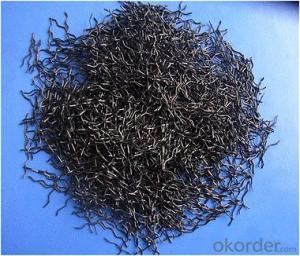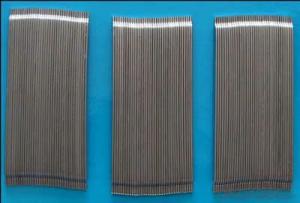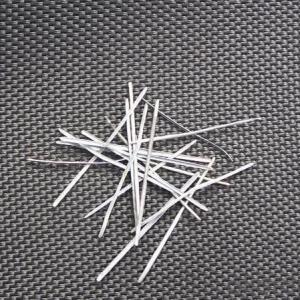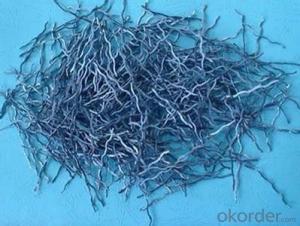Melt Extract Stainless Steel Fiber - High Tensile Strength for Concrete
- Loading Port:
- Tianjin
- Payment Terms:
- TT OR LC
- Min Order Qty:
- 1000 kg
- Supply Capability:
- 30000 kg/month
OKorder Service Pledge
OKorder Financial Service
You Might Also Like
Quick Details
Place of Origin: Jiangsu, China (Mainland)
Model Number: HT-MC
Material: Color Steel
certificated: ISO 9001
The Products
The milled steel fiber is made of high-strength steel wire through milling process, which makes the wire into wave shape to increase the touching area with concrete. By tightly binding with the mortar, the steel fiber can greatly enhance the performance of steel-fiber reinforced concrete, with strong cracking and shearing resistance, and tensile strength.
Specifications
1.material: steel plate
2.shape: waved
3.thickness: 0.5-13mm
4.length:35-5mm
5.tensile strength: >800Mpa
Specification | Thickness (mm) | Width (mm) | Length (mm) | Length- diameter l/d | Tensile strength (MPa) | Bending property |
T×W×L | 0.5-1.3 | 2-4 | 35-50 | 70~38 | ≥600 | ≥3 |
Picture
Steel fiber

any type

pp bag

FAQ
See larger image
glued steel fibre in a row >1200Mpa
In using the steel fiber, proper mixing is one of the critical step, which will decide all physics and chemistry performance of the steel fiber reinforced concrete. Therefore, scientific mixing is needed to ensure the best performance of the steel fiber reinforced concrete, so that the index will reach and exceed the desired standard.
- Q: Can melt extract stainless steel fiber be used in roller-compacted concrete (RCC)?
- Yes, melt extract stainless steel fiber can be used in roller-compacted concrete (RCC).
- Q: What is a steel fiber cement?
- Fiber concrete is a new kind of multiphase composite material, which is made up of short steel fiber reinforced by random distribution in ordinary concrete. The chaos to the distribution of steel fiber can be formed effectively hinder the propagation of concrete internal micro cracks and macro cracks, improve concrete tensile strength, bending strength, impact resistance and fatigue performance, has good ductility.
- Q: Does melt extract stainless steel fiber enhance the crack resistance of concrete?
- Concrete's crack resistance is enhanced by melt extract stainless steel fiber. To improve the tensile strength and prevent crack formation and propagation, stainless steel fibers are added to concrete mixes. Acting as reinforcement within the concrete matrix, these fibers provide additional strength and durability. When evenly dispersed throughout the concrete, these fibers form a three-dimensional network that helps distribute stress and load more uniformly. This reduces the likelihood of cracks forming and spreading, ultimately enhancing the concrete's overall crack resistance. Melt extract stainless steel fibers possess a high melting point and excellent corrosion resistance, making them highly effective in harsh environments or when exposed to chemicals. These fibers can endure high temperatures and prevent spalling or cracking of the concrete under extreme conditions. Moreover, the inclusion of stainless steel fibers improves the impact resistance and flexural strength of the concrete, rendering it more resilient to cracking caused by external forces or dynamic loads. In summary, melt extract stainless steel fiber positively contributes to the crack resistance of concrete by reinforcing the material and enhancing its tensile strength. Consequently, this leads to a more enduring and long-lasting concrete structure.
- Q: How does melt extract stainless steel fiber improve the impact resistance of airport pavements?
- Melt extract stainless steel fiber is a highly effective material that enhances the impact resistance of airport pavements. This fiber is commonly used as a reinforcement in concrete to improve its mechanical properties and increase its durability. The addition of melt extract stainless steel fiber to airport pavements significantly enhances their ability to withstand impact forces. When aircrafts land or take off, they generate tremendous amounts of pressure and impact on the pavement surface. Without proper reinforcement, this can lead to cracking, spalling, and other forms of damage. The stainless steel fiber acts as a reinforcement by dispersing the stress caused by the impact forces across a wider area. This helps to distribute the load and prevent concentrated pressure points, which are more susceptible to damage. As a result, the airport pavements become more resistant to cracking and other forms of structural failure. Moreover, melt extract stainless steel fiber also improves the overall toughness of the pavement. It effectively prevents the propagation of cracks, limiting their length and depth. This significantly reduces the risk of extensive damage and extends the lifespan of the pavement. Furthermore, the stainless steel fiber provides enhanced resistance to fatigue. Airport pavements are subjected to repetitive loading and unloading cycles that can lead to fatigue failure over time. The addition of stainless steel fiber improves the pavement's ability to withstand these cyclic loads, reducing the risk of fatigue cracks and increasing its overall resilience. In summary, melt extract stainless steel fiber is a valuable material for enhancing the impact resistance of airport pavements. Its addition to concrete reinforcement significantly improves the pavement's ability to withstand the pressure and impact forces generated by aircrafts during landing and takeoff. This reinforcement disperses stress, prevents crack propagation, increases toughness, and enhances resistance to fatigue, ultimately leading to a longer-lasting and more durable pavement.
- Q: Can melt extract stainless steel fiber enhance the resistance of concrete to acid attack?
- The resistance of concrete to acid attack can be enhanced by melt extract stainless steel fiber. Renowned for their high corrosion resistance and durability, stainless steel fibers form a network within the concrete that enhances its strength and performance. Concrete is prone to deterioration and damage when exposed to acid attack. Acids react with the calcium hydroxide in the cement paste, causing the dissolution of the concrete matrix and a decrease in its strength. However, the incorporation of stainless steel fibers into the concrete mix creates a barrier that prevents direct contact between the acid and the cement paste. The stainless steel fibers act as reinforcement, improving the mechanical properties of the concrete. They provide extra strength and toughness, increasing its resistance to acid attack. Furthermore, the fibers contribute to stress distribution and reduce crack formation, further safeguarding the concrete against acid penetration. Moreover, the corrosion resistance of stainless steel fibers ensures their integrity even in harsh environments. As a result, they can continue to reinforce and protect the concrete for an extended period. In summary, melt extract stainless steel fiber significantly enhances the resistance of concrete to acid attack. It reinforces the material, prevents direct contact between acids and the cement paste, and improves the durability of the concrete.
- Q: Does melt extract stainless steel fiber improve the ductility of concrete?
- Concrete can have improved ductility by incorporating melt extract stainless steel fiber. The addition of stainless steel fibers enhances the flexural strength and toughness of concrete. These fibers function as reinforcement within the concrete matrix, forming a network that aids in stress distribution and inhibiting crack propagation. This reinforcement enhances concrete's capacity to deform and absorb energy prior to failure, ultimately enhancing its ductility. Furthermore, stainless steel fibers possess high tensile strength and corrosion resistance, thereby further augmenting concrete's improved ductility.
- Q: What are the advantages of using melt extract stainless steel fiber in shotcrete applications?
- Using melt extract stainless steel fiber in shotcrete applications offers several advantages: 1. Enhanced durability: Stainless steel fibers have excellent corrosion resistance, making them ideal for shotcrete applications in harsh environments or structures exposed to moisture, chemicals, or high temperatures. This durability ensures the longevity and structural integrity of the shotcrete. 2. Improved crack resistance: Stainless steel fibers enhance the crack resistance and toughness of shotcrete. They distribute stress more evenly throughout the material, reducing the likelihood of cracks forming and propagating. This helps to prevent water infiltration, reinforcing the shotcrete and increasing its overall strength. 3. Increased flexural strength: The addition of stainless steel fibers in shotcrete improves its flexural strength. This reinforcement allows for greater resistance to bending or deflection, making the shotcrete more resilient under various loads or structural movements. 4. Enhanced impact resistance: Stainless steel fibers enhance the impact resistance of shotcrete, making it more resistant to external forces such as impact or vibrations. This advantage is particularly beneficial in shotcrete applications where structures may be exposed to heavy traffic, seismic activity, or significant dynamic loads. 5. Ease of application: Melt extract stainless steel fibers are easily incorporated into shotcrete mixtures, as they can be uniformly distributed throughout the material during the mixing process. This ease of application contributes to time and cost savings during construction. Overall, using melt extract stainless steel fiber in shotcrete applications provides numerous advantages, including enhanced durability, improved crack resistance, increased flexural strength, enhanced impact resistance, and ease of application.
- Q: Can melt extract stainless steel fiber be used in high-temperature applications?
- Certainly, the utilization of melt extract stainless steel fiber is applicable in high-temperature scenarios. This particular variant of stainless steel fiber is engineered specifically to endure extreme levels of heat and is typically employed within industries such as aerospace, automotive, and construction, where elevated temperatures are prevalent. The melt extract procedure guarantees that the stainless steel fiber possesses remarkable thermal stability, enabling it to preserve its structural integrity even when subjected to heightened temperatures. Furthermore, stainless steel is renowned for its ability to resist oxidation and corrosion, rendering it suitable for extended periods of exposure to high temperatures without any deterioration. In summary, melt extract stainless steel fiber represents an optimal selection for high-temperature applications due to its enduring nature, heat resistance, and resistance to oxidation.
- Q: How does melt extract stainless steel fiber improve the durability of concrete?
- There are several ways in which melt extract stainless steel fiber can enhance the durability of concrete. Firstly, the addition of these fibers increases the concrete's tensile strength and flexural properties. As a result, the concrete becomes less prone to cracking and can bear higher levels of stress and load. The fibers act as reinforcement within the concrete matrix, effectively bridging any cracks that may occur and preventing them from spreading further. Furthermore, the presence of stainless steel fibers also boosts the concrete's resistance to impact. These fibers absorb and distribute the impact energy, reducing the chances of surface spalling or fragmentation. This enhances the durability of the concrete, enabling it to withstand heavy impacts or dynamic loading conditions. Moreover, stainless steel fibers contribute to the concrete's resistance to corrosion. Since these fibers are made from stainless steel, they possess high resistance to rust and other forms of corrosion. By incorporating stainless steel fibers into the concrete mix, a protective barrier is created against aggressive chemicals, moisture, and other environmental factors that could lead to corrosion and deterioration. This significantly prolongs the lifespan of the concrete structure, minimizing the need for costly repairs or replacements. In conclusion, melt extract stainless steel fiber improves the durability of concrete by enhancing its tensile strength, flexural properties, impact resistance, and corrosion resistance. As a result, the concrete structure becomes more resilient and long-lasting, capable of withstanding harsh conditions and heavy usage.
- Q: What is the effect of melt extract stainless steel fiber on the alkali-silica reaction in concrete?
- The effect of melt extract stainless steel fiber on the alkali-silica reaction in concrete is generally positive. The alkali-silica reaction is a chemical reaction that occurs between the alkalis in cement and certain types of reactive silica present in aggregates used in concrete. This reaction can cause significant expansion, cracking, and deterioration of the concrete over time. However, when melt extract stainless steel fibers are added to the concrete mix, they can act as a reinforcement and help mitigate the effects of the alkali-silica reaction. The stainless steel fibers provide additional structural support to the concrete, reducing the potential for cracking and improving the overall durability of the material. The stainless steel fibers also help to control the expansion caused by the alkali-silica reaction by providing a physical barrier that restricts the movement of the reactive silica particles. This helps to prevent the formation of cracks and limit the damage caused by the reaction. In addition, the stainless steel fibers enhance the mechanical properties of the concrete, including its tensile strength, flexural strength, and impact resistance. This can further improve the performance of the concrete in various applications, such as in high-stress environments or in structures where durability is crucial. Overall, the addition of melt extract stainless steel fiber to concrete can effectively reduce the negative effects of the alkali-silica reaction, enhancing the long-term performance and durability of the concrete.
Send your message to us
Melt Extract Stainless Steel Fiber - High Tensile Strength for Concrete
- Loading Port:
- Tianjin
- Payment Terms:
- TT OR LC
- Min Order Qty:
- 1000 kg
- Supply Capability:
- 30000 kg/month
OKorder Service Pledge
OKorder Financial Service
Similar products
Hot products
Hot Searches
Related keywords




























